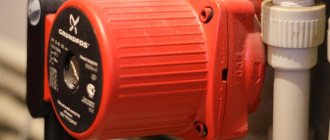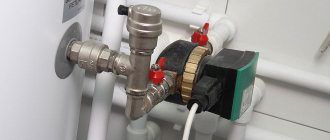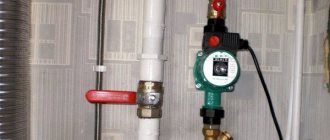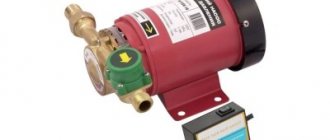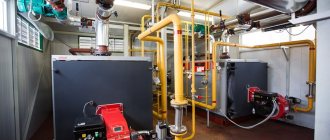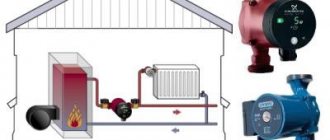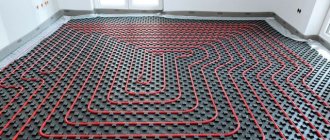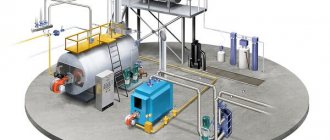How to choose a circulation pump for heating
To select equipment taking into account the most suitable parameters, you must use certain formulas
. However, only specialists know which formulas need to be used in each specific case. And if the device is selected by an unknowing person, then you should use the following recommendations:
- Marking of the circulation pump
. For example, Grundfos UPS 25-50 equipment, where the first two digits indicate the thread diameter of the nuts - 25 millimeters (1 inch), which are supplied with the device. There are also pumps with nut diameters of 32 millimeters (1.25 inches). The second two digits are the maximum height of coolant rise in the heating system - 5 meters, that is, using a circulation pump, an excess pressure of no more than 0.5 atmospheres can be created. There are also pumps in which the lift height is 3, 4, 6 and 8 meters. - Unit performance
.
It is the main parameter that determines the operation of the unit. Represented by the volume of coolant pumped using a pump. The formula used for calculation is: Q=N:(t2-t1), - where N is the power of the heat source. This could be a boiler or a gas water heater;
- t 1 – shows the temperature of the water in the return pipe. As a rule, it is +65-70 0 C;
- t 2 - shows the temperature of the water that is in the supply pipeline (coming out of the boiler or geyser). Often the boiler maintains +90-95 0 C.
- Calculation of the heating system and its losses is carried out in order to correctly select the design parameters of the unit that is able to cope with the resistance in the heating system.
. Shows the maximum pressure that the heating system is capable of. This is the total value of hydraulic resistance in the heating system. When calculating hydraulic resistance, the number of floors of a heated building with a closed heating system is not taken into account. In this case, the average value is taken - 2-4 meters of water column. In low-rise buildings with a traditional heating system, this figure is identical.
This is another parameter that is worth considering when choosing a circulation pump, albeit indirectly. This indicator is indicated in the building's passport during its design. If these values are missing, they can be calculated. Each country has its own heat standards per square meter. According to European standards, 100 W are required to heat 1 square meter of a one- or two-apartment building, and 70 W for an apartment building. The Russian standard is presented in SNiP 2.04.05-91.
. Any heating circulation pump has three connection positions to the electrical network. All information regarding the electric current consumption of the pump is contained in the plate on the unit body (load parameters). Each switch position corresponds to a new pump performance, that is, the amount of coolant per hour pumped by the device through the heating system. The third position of the switch shows the maximum performance of this unit, and the maximum current consumption by the pump is indicated on the plate on the pump body.
Mass-produced equipment has average characteristics. Therefore, it is necessary to take into account the individuality of each heating system.
Note! Selecting a suitable pump should take into account the ability of the unit to operate in several modes, and its power should exceed the design power by 5-10 percent
Boiler pump types
Network units are among the largest pumping equipment in a boiler room, although they are not the only pumping mechanisms.
There are the following types of pumps used in boiler installations:
- nutrient steam and water;
- make-up;
- raw water;
- network circulation pumps;
- liquid fuel recycling;
- fuel oil;
- condensate
All units are carefully pre-calculated and selected in the relevant sections of the boiler installation project. This is due to particularly high requirements for the reliability of the equipment used to ensure the production of thermal energy.
The main purpose of all pumps is to circulate and supply the medium to the distribution point. At the same time, they must work continuously for a long time.
Network pump and its purpose
This unit must pump the heating fluid in the supply pipeline at the optimal speed and pressure according to a temperature schedule of 150-70 C, depending on the outside air temperature. Their feature is the proximity of the cooling system circuit to its seals.
They are also distinguished by their productivity and high efficiency. Unit parts, for example, the casing and impeller, are made of durable cast iron alloy, which ensures wear resistance of the entire structure.
The reliability of the design development is confirmed by many years of experience in operating units in areas of high temperatures and water hammer. The circulation unit is unpretentious and does not require labor-intensive maintenance.
They are easily installed in a thermal system, have a simple design and a long guaranteed period of operation. Conditions for selecting a network unit - operating pressure, maximum temperature of heated water, quality of the working environment. They are intended for water with a concentration of mechanical impurities not exceeding 5 mg/l.
Feed pump and its purpose
This group of units works only with steam boilers with a pressure above 0.7 ati; they serve to fill the boiler with water to replace the amount that was spent on generating steam and purging salt water from the boiler.
This is a very important unit; the boiler’s performance depends on its reliability, and if it is not fed with water, overheating of the pipe heating surfaces will occur, followed by an explosion of the steam generator.
Therefore, the requirements of Kotlonadzor require the mandatory installation of at least two feeding units, with different movements of the working surface - one with a steam converter, and one with an electric source.
There are also requirements for the minimum performance of devices; each must provide 150% of the load of simultaneously operating boilers, that is, work with a significant margin.
If, according to the scheme, 3 or more units are installed in the boiler room, the type is selected in such a way that when the most powerful one comes out, the total performance of the pumps remaining in operation provides 120% of the rated load of the boilers. Electric centrifugal and piston steam pumps are used.
Raw water pump
This group of pumps is used in a chemical water treatment system. Their task is to take the environment from the raw water tank and direct the water for chemical purification from hardness salts and suspended solids; after processing, it enters the chemically purified water tank or deaerator to remove excess oxygen.
Typically, these are units of low power and operating pressure, since they operate in a closed circuit of a pipeline system that does not have large hydraulic losses.
Its operation can be carried out by the HVO operator manually, through the “Start” button, or by an automation system using water level sensors in the tank. The selection is made according to the design capacity of the chemical water treatment system, taking into account 100% reserve.
If the raw water unit fails, the deaerator will not be fed, the reserves of which are usually enough for several hours of boiler operation; subsequently, the boiler will be stopped by the safety automatics due to the low water level in the deaerator.
Condensate
Condensate pumps are used at large thermal facilities, for example, at thermal power plants, where they are used to pump condensate obtained from waste steam and supply it through a group of low-pressure heaters to deaerators, and in steam heating circuits of industrial enterprises, when it is necessary to pump waste condensate from consumers to the boiler room.
They are characterized by low operating pressures, since they are limited by the pressure of the medium in the condensate collectors; therefore, when designed, they require high anti-cavitation protection, since even a slight decrease in the pressure of the medium at the time of pumping causes it to boil.
Condensate pumps in the circuits are installed with a reserve of 2 to 4 units. Productivity is calculated based on the maximum volume of condensate, and the pressure must be sufficient to extinguish the resistance in the system between the condensate pipeline and the deaerator, taking into account the hydrostatic pressure due to the difference in levels of the equipment installation sites: condensate collector - lower installation at the “zero” level, deaerator - upper , approximately on the second or third floor of the boiler room building.
Charge pump
This device serves the heating installation in the thermal circuit of the boiler house and is designed to replenish water leaks from the main network.
Its performance is calculated based on the volume of the heat supply network, based on the standards of certain SNIPs and is carried out when calculating the thermal scheme. In this case, the resulting performance is equal to double the margin for standard leaks in the network, amounting to 0.75% of the total volume of water in the system.
The number of units must be at least two, equal to productivity, one of which must be a backup. The pumps are installed on the return line, so their operating pressure must exceed the pressure in it by at least 50%. Control is performed manually by boiler room operators, based on the pressure drop in the return network water, and automatically when the low pressure sensor in the network is triggered.
How to use a boiler room thermal diagram
The thermal circuit helps monitor the condition and operation. Due to flue gases, corrosion of low-temperature or sulfuric acid metal coatings cannot be ruled out. And to prevent it from appearing, the water temperature should be monitored. It is noteworthy that at the entrance to the boiler the optimal temperature will be 60-70 degrees.
And in order to be able to increase the temperature to the required levels, a recirculating pump is installed. Water heating boilers need to be monitored so that their service life is decent; control the consistency of water consumption. Typically, the minimum data for this indicator is set by the manufacturer.
In order for boiler rooms to work well, you need to use vacuum deaerators. Typically, a water jet ejector will create a vacuum, and the released steam will be used for deaeration. But, the main thing that they are afraid of when installing a boiler room is permanent attachment to the place. Modern automation simplifies many processes.
Features of connecting pumping equipment
If a forced circulation system is used to service the house, then when the electrical power is turned off, the boiler pump must continue to operate, receiving energy from a backup source. In this regard, it is best to equip the heating system with a UPS, which will maintain the operation of the structure for several more hours. External batteries connected to it will help extend the life of the backup source.
When connecting the pump, you must avoid the possibility of condensation and moisture getting into the terminals. If the coolant heats up to more than 90 °C, then a heat-resistant cable is used for connection. You will also need to avoid contact of the pipe walls and power cable with the motor and pump housing. The power cable is connected to the terminal box on the right or left side by changing the location of the plug. In the case of a side-mounted terminal box, the cable must be routed only from the bottom. A prerequisite is that grounding must be connected to the pump.
Mains pumps are often used in boiler rooms. Such products perform the function of pumping hot water in a heating network system. The temperature of the network water, which the installed unit is capable of driving through the pipes, reaches +180 degrees.
At the same time, the device and design of network pumps are relatively simple, and at the same time, the devices show a high level of performance along with reliability.
Feed pump for steam boiler device device
Each pump for a heating boiler performs its tasks in a closed-type heating system. The main element of such a pump is the rotor, on which the efficiency of the unit directly depends. When the pump operates, the rotor rotates inside the stator, which is fixedly mounted on a solid base. Some models are equipped with a ceramic stator, which protects the rotor from limestone.
The edges of the rotor are equipped with blades, the rotation of which pushes the coolant further through the pipes. For the most part, boiler pumps are equipped with one rotor, but there are models with several working elements. The rotor is driven by an electric motor. The motors of most pump models are characterized by high power and long service life. All pump elements are housed in a durable aluminum or stainless steel housing.
Rules for installing boiler pumps
Any equipment, be it a unit for a heating system, or a pump for flushing boilers, must be installed strictly in accordance with the manufacturer’s recommendations. One of the most important conditions is to choose the correct location of the device. The pump shaft must be positioned strictly horizontally. Otherwise, air pockets will form inside the system, which will leave the bearings and other elements of the unit without lubrication. The result of this will be rapid wear of the device parts.
Another important condition is the correct choice of location for inserting the pump. The unit must force liquid to move through the pipeline
The standard installation diagram of the device is shown in the image below.
The main elements in the diagram are shown in this order:
- boiler;
- coupling connection;
- valves;
- alarm system;
- pump;
- filter;
- membrane type tank;
- heating radiators;
- liquid feed line;
- Control block;
- temperature sensor;
- emergency sensor;
- grounding
This scheme ensures the most efficient operation of the pump and heating system. At the same time, energy consumption by each individual element of the system is reduced to a minimum.
Classification
All pumps are divided into two types:
Dry rotor pump
The working part of the rotor does not have direct contact with water thanks to the protection of several sealing wheels. These parts are made from carbon agglomerate, high-quality steel or ceramics, aluminum oxide - it all depends on the type of coolant used.
The device is launched by the movement of the rings relative to each other. The surfaces of the parts are perfectly polished, in contact with each other, they create a thin layer of water film. As a result, a sealing connection is created. With the help of springs, the rings are pressed towards each other, due to which, as the parts wear out, they independently adjust to each other.
The service life of the rings is approximately three years, which is much longer than the life of the stuffing box, which requires periodic lubrication and cooling. The efficiency indicator is 80 percent. The main distinguishing feature of the unit is its high noise level, as a result of which a separate room is required for its installation.
Glandless rotor pump
The working part of the rotor - the impeller - is immersed in the coolant, which simultaneously acts as a lubricant and as an engine coolant. Using a sealed stainless steel cup installed between the stator and rotor, the electrical part of the engine is protected from moisture.
As a rule, ceramics are used
, for bearings - graphite or ceramics, for the housing - cast iron, brass or bronze. The main feature of the unit is its low noise level, long period of use without maintenance, easy and simple settings and repairs.
The efficiency indicator is 50 percent. This is explained by the fact that sealing the metal sleeve, which separates the coolant and the stator, is impossible if the rotor diameter is large. However, for domestic needs, where coolant circulation is ensured in short-length pipelines, it is advisable to use such circulation pumps.
Composed of a modular design
modern “wet” type devices include:
- Frame;
- Electric motor with stator;
- Box with terminal blocks;
- Working wheel;
- A cartouche consisting of a shaft with bearings and a rotor.
The modular assembly is convenient because at any time it is possible to replace a failed part of the circulation pump with a new part, and accumulated air can be easily removed from the cartouche.
Grundfos make-up pumps develop quite high pressure
How to get a discount?
Click “I like”
Print the coupon
Get a discount!
- Click the “like” button on any of the presented social networks.
- In the pop-up window that appears, click the “print coupon” button. A discount coupon will appear in front of you.
- Print out a coupon that entitles you to a discount of 5% to 20% on products and services of our company!
Authorized Grundfos service partner
Service
warranty and post-warranty
on objects of any complexity
Commissioning
Pumping technology has evolved quite a lot since its introduction into the national economy. At the moment, such devices are often equipped with all kinds of automation. Starting from protection against dry running, mechanical check valves that prevent reverse flow of the pumped substance, and ending with powerful electronic units that allow you to regulate the rotation speed, changing the frequency of the electric current, and measure various characteristics in real time: temperature, current, flow rate, and the like .
These processes did not pass by Grundfos pumps for recharging the heating system and boiler. These modern devices combine excellent quality with the use of the latest achievements of science and technology. Despite, at first glance, their auxiliary function, these devices are capable of creating quite high pressure, which allows them to be used even during the initial filling of the system, or during a planned replacement of the coolant.
And for a more detailed overview of the range, you can refer to the catalog of Grundfos charging pumps, located on the website of the official representative of the manufacturer in our country.
Installation of a chiller and air conditioning system in a shopping center building on Kashirskoye Shosse in Moscow
Employees of JSC “Unified Service Center” installed a chiller and related equipment in the building of a shopping center on Kashirskoye Shosse.
Where to buy “Grundfos charging pumps”?
Shipment of the product “Grundfos make-up pumps”
– pick up at the address Moscow, 127282, Polyarnaya street, building 31A, building 1. (show map)
In other cities
The cost of delivery to these cities depends on the availability of goods at the local warehouse. You can check current availability by calling our office in your city:
We can offer you the lowest possible price and shortest delivery times compared to competitors in your region.
The role of Grundfos booster pumps in the heating system
For heating systems, the role of pumping technology is especially important. Firstly, many modern systems require forced circulation of coolant in the circuit, and secondly, from time to time the system requires replenishment of the volume of coolant fluid. It is possible to create an absolutely sealed circuit, but this will not be a panacea, because after a certain period of time a partial or complete replacement of the coolant is required, depending on the technical conditions of the heating system. Also, do not forget about scheduled maintenance, which involves flushing the radiators and the circuit as a whole, which implies depressurization of the heating circuit. Therefore, regardless of the geographical location of the owner of the heating system (for example, in Lyubertsy), he will need a Grundfos feed pump.
Why are make-up pumping units needed?
The answer to this question covers many areas of industrial and domestic applications. We are talking about air conditioning, heating, ventilation and other engineering structures. And implementation in various auxiliary and main production processes allows the use of Grundfos booster pumps even for aggressive environments and liquids. This will ensure the non-stop operation of a production line, for example a SIP washing machine, which is a critical element in the food industry.
Various designs of the units allow them to be used under any environmental conditions: in a residential area, in a workshop, in a boiler room, outdoors. After all, the manufacturer has taken care of all possible ways to use this type of equipment. And even a Grundfos street pump has been developed, which is popular in Korolev and Mytishche.
Now you only need to carefully select the model of the required booster pump, based on the technical conditions of your system.
Frequency converter functions
Modern frequency converters for boiler houses are multifunctional devices. They:
- Provide limitation of starting currents when starting engines.
- Allows you to smoothly regulate the pressure and pressure in the system.
- Automatically control pump performance depending on the actual needs of heat consumers.
- They shut down units in case of accidents and abnormal operating conditions.
- Allows you to automate the operation of boilers according to a given program or events.
Frequency converters also support basic communication protocols, with their help you can remotely monitor and control boiler pumps.
The devices also have built-in memory for storing data about activations, shutdowns, errors and other events.
Monoblock pump
Previously, pumping units mounted on a foundation or frame, consisting of a pump and a drive, were used as network pumps. Mechanical energy was transmitted from the drive to the pump through a group of drive mechanisms. This was primarily due to the need to use powerful drives.
- The modern range of pumping equipment allows the use of monoblock pumps as network pumps.
- The use of monoblock pumps allows, first of all, to significantly save installation space.
- This is especially true when using monoblock pumps with a vertical shaft.
- The use of modern pumping equipment when modernizing existing boiler houses makes it possible to reduce the required installation area by two or more times.
Buy a network monoblock pump from Interpamps
Interpamps LLC offers reliable pumping equipment of the Etaline and Etaline-R series, with a capacity of up to 2000 cubic meters per hour, and a pressure of up to 100 meters of water column, designed for operating pressure up to 25 bar and temperatures from -30 to +140 degrees Celsius . Due to their design and operating parameters, Etaline pumps can be used as network pumps, both in stationary boiler houses and in block-modular ones. The nozzles located on the same axis in Etaline pumps greatly simplify the piping of the pumps. Allowing, among other things, the installation of Etaline pumps directly into an existing pipeline without changing the latter. The high efficiency and reliable design of the pumps can significantly reduce the cost of subsequent operation.
The central office of Interpamps LLC is located in Moscow, we offer our partners to buy high-quality pumping equipment inexpensively. We select pumping equipment at the request of our partners free of charge and in the shortest possible time.
The circulation pump for a heating system boiler performs a rather important function - it is responsible for the uninterrupted circulation of coolant through pipes and radiators. The efficiency of the heating system and the comfort of living in a private house or apartment largely depend on the choice of unit.
Application of frequency converters for network pumps
Network pumps are designed to ensure circulation of coolant from the boiler to consumers and back. Using VFD:
- Allows you to automatically maintain network pressure in accordance with a given program.
- Provides variable operation of pumping units based on operating hours. The converters also automatically connect backup pumps in case of insufficient performance or failure of the main ones.
- Provides smooth start and stop, without the risk of water hammer.
- Allows for remote monitoring and control, adjustment of current characteristics.
Frequency converters also protect motors from overloads, voltage surges, unbalanced loads, emergency modes and transmit information to the dispatch center.
Monoblock pump
Previously, pumping units mounted on a foundation or frame, consisting of a pump and a drive, were used as network pumps. Mechanical energy was transmitted from the drive to the pump through a group of drive mechanisms. This was primarily due to the need to use powerful drives.
- The modern range of pumping equipment allows the use of monoblock pumps as network pumps.
- The use of monoblock pumps allows, first of all, to significantly save installation space.
- This is especially true when using monoblock pumps with a vertical shaft.
- The use of modern pumping equipment when modernizing existing boiler houses makes it possible to reduce the required installation area by two or more times.
Buy a network monoblock pump from Interpamps
Interpamps LLC offers reliable pumping equipment of the Etaline and Etaline-R series, with a capacity of up to 2000 cubic meters per hour, and a pressure of up to 100 meters of water column, designed for operating pressure up to 25 bar and temperatures from -30 to +140 degrees Celsius . Due to their design and operating parameters, Etaline pumps can be used as network pumps, both in stationary boiler houses and in block-modular ones. The nozzles located on the same axis in Etaline pumps greatly simplify the piping of the pumps. Allowing, among other things, the installation of Etaline pumps directly into an existing pipeline without changing the latter. The high efficiency and reliable design of the pumps can significantly reduce the cost of subsequent operation.
The central office of Interpamps LLC is located in Moscow, we offer our partners to buy high-quality pumping equipment inexpensively. We select pumping equipment at the request of our partners free of charge and in the shortest possible time.
If the boiler room is designed correctly, it will serve the heating system, ventilation, and supply of hot and cold water. It can be said that no one designs communications independently. Focus on at least a standard plan. Its choice depends on the type of room for which it is intended.
The graphic drawing must reflect all the mechanisms, apparatus, instruments, as well as the pipes connecting them. Standard boiler room plans include boilers, pumps (circulation, make-up, recirculation, network), and battery and condensation tanks. Also provided are devices for fuel supply and combustion, as well as devices for deaerating water, heat exchangers, the same fans, heat shields, and control panels.
Those heating networks that operate on water are divided into two groups:
- Open (the liquid is taken from local installations);
- Closed (water returns to the boiler, giving off heat).
The most popular example of a schematic diagram is an example of an open-type hot water boiler house. The principle is that a circular pump is installed on the return line; it is responsible for delivering water to the boiler, and then throughout the entire system. The supply and return lines will be connected by two types of jumpers - bypass and recirculation.
The technological diagram can be taken from any reliable sources, but it would be good to discuss it with specialists. He will advise you, tell you whether it is suitable for your situation, and explain the entire system of action
In any case, this is the most important structure for a private home, so maximum attention should be paid
Network pumps type SE
| Pump unit size | Pump parameters | Motor parameters | Dimensions of the pump unit, mm | Ma, kg | |||||
| Q, m3/h | H, m | Type | Nd kW | n, min-1 | L | B | H | ||
| SE 500-70-16 | 500 | 70 | 5AN280A2 | 160 | 2950 | 2300 | 1050 | 1065 | 2328 |
| SE 800-55-11 | 800 | 55 | 5AN315A4 | 200 | 1450 | 2485 | 1155 | 1102 | 2710 |
| SE 800-100-8 | 800 | 100 | 5AN355A2 | 315 | 2950 | 3720 | 1695 | 1500 | 4840 |
| SE 800-100-11 | 800 | 100 | 5AN355A4 | 315 | 1450 | 3995 | 1370 | 1840 | 5250 |
| SE 1250-70-11 | 1250 | 70 | 5AN355A4 | 315 | 1450 | 3080 | 1236 | 1235 | 4200 |
| SE 1250-140-8 | 1250 | 140 | n/a | 800 | 2950 | 4073 | 1695 | 1515 | 5860 |
| SE 1250-140-11 | 1250 | 140 | A4-400U4 | 630 | 1450 | 4375 | 1530 | 2220 | 7365 |
| SE 2500-60-8 | 2500 | 60 | A4-400U4 | 630 | 1450 | 3995 | 2345 | 2070 | 7980 |
| SE 2500-60-11-1 | 2500 | 60 | A4-400U4 | 630 | 1450 | 3995 | 2305 | 2070 | 7210 |
| SE 2500-180-8 | 2500 | 180 | 4АЗМ1600/6000 | 1600 | 2950 | 4770 | 1975 | 1710 | 8580 |
| SE 2500-180-10 | 2500 | 180 | 4АЗМ1600/6000 | 1600 | 2950 | 4410 | 1770 | 1610 | 6800 |
| SE 5000-70-5 | 5000 | 70 | 4АЗМ1250/6000 | 1250 | 2950 | 4365 | 1940 | 1720 | 10400 |
| SE 5000-160-8 | 5000 | 160 | 4АЗМ3150/6000 | 3150 | 2950 | 5450 | 1900 | 1590 | 13900 |
| SE 5000-160-10 | 5000 | 160 | 4АЗМ3150/6000 | 3150 | 2950 | 5450 | 2175 | 2210 | 13200 |
What you need to know about it
First of all, it is advisable to study the design of the heating system and understand the essence of its operation. Let's start with the fact that heating begins with boiler rooms, where some kind of fuel is burned (gas, coal, wood), and then the heat is transferred through pipes using a coolant. There are several types of coolants: air, steam and the most common - water. But water tends to freeze at low temperatures. Therefore, where necessary, antifreeze diluted with water is used in order to reduce the negative destructive effect on the pipeline. A calculation is made to help determine the correct ratio of water and antifreeze. With central heating, the coolant can be directed through a pumping system or through a conventional one.
The conventional, or natural, system is very simple: water heated in the boiler moves through some pipes, warming up the radiators, and then returns through others to heat up again. This simple device also has an expansion tank and air vents. The latter are needed in order to eliminate air bubbles and various gases that may accumulate in the pipes. And excess moisture, which appears when water expands from heating, goes into the expansion tank.
A closed heating system is characterized by a pump. It helps to accelerate the water faster than it moves in a conventional pumpless system. A pump is especially needed if the pipes are too narrow and this prevents the coolant from circulating.
What pumps are used for boiler rooms
Network pumps for boiler houses are most often centrifugal, equipped with an electric motor. By type they can be divided into: condensate, network, make-up, intended for raw water. You can also find this type of pump as a nutrient pump.
In water supply boiler systems, it is customary to install several devices at once that have the same characteristics. The pumps are connected in parallel, with one of them being the main one, and the second being a backup and starting as needed when the first one fails. However, it is also possible to operate two devices at once. In this case, the water pressure in the pipes remains the same as when operating one installation, but the water supply increases, the level of which becomes equal to the sum of the supply of each of the devices.
Pumps for boiler rooms can have enormous weight and dimensions
For boiler houses, the best option would be to install a centrifugal 1-stage pump type KM, a 1-stage unit type D with 2-way suction, or a multi-stage product type TsNSG. In addition, many professionals recommend installing condensate type KS units in the boiler room. In this case, the final choice depends on the specific requirements of the buyer, which, as a rule, are determined by the operating conditions of the future equipment.
Selecting a device and calculating the required pressure
Pumps for boiler rooms are selected strictly based on the requirements of the heating system, or more precisely, on the required pressure. To understand what pressure is needed for optimal operation of your system, you can refer to the formula created for this purpose.
The formula at first glance does not look the simplest, but when studying each value, calculating the required pressure is not difficult. The symbols in the formula by which you can calculate the required pressure mean:
Along with the pumps, pressure gauges, taps, and filters are installed
- H – the required pressure value in meters of water column;
- Ltotal is the total length of the circuits, taking into account the return and supply pipes. If you use a heated floor, you need to take into account the length of the pipes laid under the floor in the calculation;
- Rsp is the specific resistance level of the system pipes. Taking into account the reserve, take 150 Pa per 1 linear meter;
- r is the total resistance value of the system pipeline;
- Pt – specific density of the coolant;
- G is a constant that is equal to 9.8 meters per square centimeter, or the unit of acceleration due to gravity.
It is often difficult to calculate the total resistance of system elements. However, in this case, you can simplify the general formula by replacing the coefficient k, which is a correction factor, instead of this sum. Thus, the correction factor of a system in which any thermostats are installed will be equal to 1.7.
For a conventional system with standard fittings and taps that do not have elements for thermostatic regulation, the correction factor is 1.3. A system that has many branches and highly saturated shut-off and control valves has this coefficient at 2.2. The calculation using the final formula, in the case of a correction factor, will have the following form: H=(Lsum*Rud*k)/(Pt*g).
By calculating using this formula, you will be able to understand what parameters and characteristics the pump you need to purchase has. We emphasize that it is recommended to choose a pump for boiler rooms whose power will not exceed that necessary to create the required pressure. If you buy a pump with more power than is needed to provide the desired pressure, you will simply be wasting your money.
Scope and characteristics
Characteristic features of network pumping devices are ease of installation and low maintenance. Materials such as high-quality steel and gray cast iron, from which such equipment is made, help to increase the safety margin and durability of the pump. The technical characteristics of network pumps allow them to work with predominantly clean water, which should not contain solid parts with a diameter greater than 0.2 mm, as well as more than 5 mg/l of mechanical impurities.
Most often, network pumping devices are used to create water circulation in heating networks, as well as to service a boiler (heating) network installation. Such units are manufactured both with one gear and in a 2-stage version. The drive operates using electric power units (motors). They look like horizontal pumps.
The units also include in their device:
- housing with horizontal connector;
- impeller with double-sided water inlet;
- bearings, shaft and end sealing elements;
- chambers for end seals and flanges for mounting bearings installed in the housing;
- rolling bearings that support the rotor;
- roller or ball support bearing for drive;
- bearing for the radial axis.
The average water supply of devices for boiler houses is 450-500 cubic meters per hour, the pressure is around 50-70 m, and such a parameter as inlet pressure varies within 16 kilograms per square centimeter. Pumps whose purpose is to circulate hot water in small heating systems have lower power and performance indicators, but they also cost an order of magnitude cheaper.
The scope of application of network products is not limited only to heating systems, in particular boiler rooms. This equipment is successfully used for supplying fuels and lubricants to bases, warehouses and industrial enterprises, for pumping reagents into water treatment plants, as well as in water treatment systems designed for pumping water into water supply systems when the pressure level in pipes drops. At the same time, such equipment is also used for cleaning tanks, as well as storage facilities for substances such as fuel oil.
Automation and boiler installation diagram
Automation makes it possible to use a set of programs that control heat flows. It also depends on the daily routine and the weather. This is also needed for heating additional rooms: a playroom, a swimming pool.
There are some popular user functions that adapt the operation of the equipment taking into account the lifestyle of the home owners. This is both a conventional hot water supply system and a set of some individual options that are convenient and economical for these particular residents. In the same way, you can develop a boiler room automation scheme by choosing one of the popular modes.
Glandless circulation pumps
In this case, the pump rotor in the heating boiler room is lowered directly into the water. Thanks to the special design, the coolant circulating in the heating circuit acts simultaneously as a lubricant and coolant for individual parts of the pump. This type of equipment is characterized by almost silent operation, since most sounds and vibrations are absorbed by the liquid in which the pump is immersed.
Installing a water pump in a heating system is possible both for heating the room only and for auxiliary supply of hot water to residents. These installations are widely used in industrial facilities and private residential buildings. The only difference is that more powerful units are used in industry.
You can verify the functionality of the device by visual inspection (you need to unscrew the back cover), as well as using hardware diagnostics.
